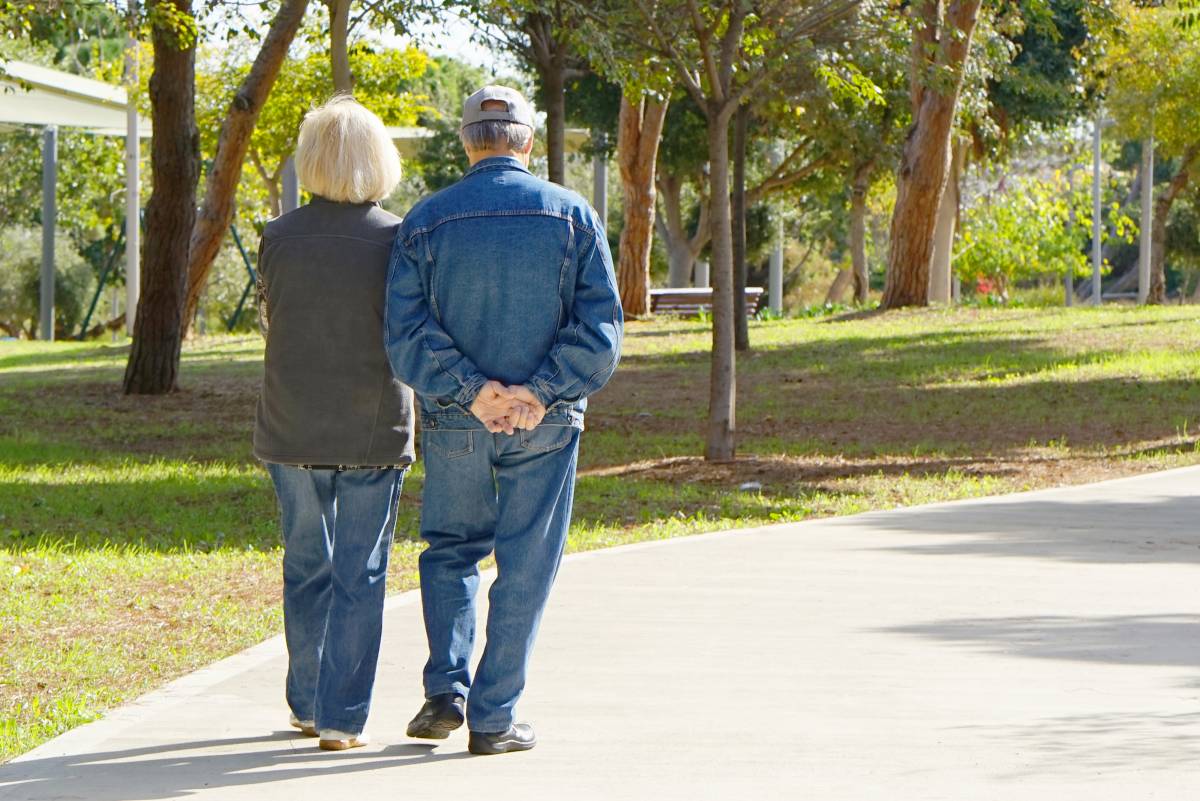PhysioUpdate 19th May 2022
Giving frail older people living in the community a programme of regular exercise alongside expert dietary advice has been linked to a reduction in their mobility problems, a paper appearing in today’s edition of The BMJ (12 May) suggests.
The paper’s first author is Roberto Bernabei, who works at the department of geriatrics and orthopaedics at the Università Cattolica del Sacro Cuore in Rome. The large team conducted a trial conducted as part of the Sarcopenia and Physical fRailty IN older people: multi-componenT Treatment strategies (SPRINTT) project.
Participants combined aerobic (walking), strength, flexibility, and balance exercises with personalised nutritional counselling. As a result, the level of mobility disability among them fell by almost a quarter (22 per cent) over three years.

Randomised control groups
A pool of 1,519 men and women (average age 79 years) with physical frailty and sarcopenia (a combination of reduced physical function and low muscle mass) were recruited from 16 clinical sites in 11 European countries from 2016-2019. Of these, 760 participants were randomised to the intervention, 759 received education on healthy ageing (controls), and all were monitored for up to 36 months.
Those deemed to be physically frail and to have sarcopenia had physical performance battery (SPPB) scores of three to nine points (score range 0 to 12, with lower scores indicating poorer physical function) and low levels of muscle mass. They could walk 400 metres in 15 minutes independently.
The intervention group received twice weekly moderate intensity physical activity sessions at a centre and up to four times weekly at home alongside personalised nutritional counselling. Activity was measured by actimeters worn on the participants’ thighs.
Controls followed instructor-led sessions
Controls received education on healthy ageing once a month and a brief instructor-led programme of upper body stretching exercises or relaxation techniques. Among participants with SPPB scores of from three to seven at the start of the trial, mobility disability occurred in 47 per cent assigned to the intervention and 53 per cent of the controls.
Persistent mobility disability (inability to walk 400 metres on two consecutive occasions) occurred in 21 per cent of intervention participants compared with 25 per cent of controls. SPPB scores increased more in the intervention group than in controls at both 24 months and 36 months (average differences of 0.8 and 1 point, respectively).
Women in the intervention group lost less muscle strength (0.9 kg at 24 months) and less muscle mass (0.24 kg and 0.49 kg at 24 months and 36 months, respectively) than control women, but no significant group differences were seen in men.
The risk of adverse events was, however, greater among intervention participants (56 per cent) than controls (50 per cent). In a separate analysis of participants with better mobility (SPPB scores of 8 or 9 at the start of the trial), the intervention did not affect the risk of developing mobility disability and had marginal effects on physical performance.
Trial had some limitations
The team of researchers acknowledge that their approach had some limitations. For example, older adults with important cognitive deficits were not included, and almost all participants were white, so findings may not apply to other ethnic groups.
However, retention and adherence to interventions were high compared with other similar trials, and their use of validated tests in a geographically and culturally diverse group of frail older people across Europe, suggests that results are solid. As such, they conclude that such an intervention ‘may be proposed as a strategy to preserve mobility in older people at risk of disability’.
'Compelling evidence'
[The findings help to] ... provide compelling evidence that mobility in the community can be preserved among vulnerable older people through structured physical activity, with walking as the primary modality [Thomas Gill, Yale School of Medicine]
In a linked editorial, Thomas Gill, Humana Foundation professor of geriatric medicine at the Yale School of Medicine, Connecticut, argues that findings presented by Dr Bernabei and his colleagues help to confirm the benefits of structured physical activity in older adults living in the community.
Professor Gill acknowledges that translating even the best designed trial findings into clinical practice can be challenging, but says these findings, along with those from another large US trial (the LIFE Study), ‘provide compelling evidence that mobility in the community can be preserved among vulnerable older people through structured physical activity, with walking as the primary modality’.
Confirming these findings in SPRINTT ‘would further strengthen the case for developing, implementing, and supporting community based physical activity programmes to preserve independent mobility among vulnerable older people’, he concludes.
Factfile
- US and EU data indicate that about 13 per cent of adults aged 70 years and older living in the community have mobility disability
- these problems are linked to a poor quality of life, admission to hospital or residential care, and death, as well as greater healthcare costs
- safe and effective ways are needed to preserve mobility in older people, who are at risk of further decline
To see the full version of the paper, titled Multicomponent intervention to prevent mobility disability in frail older adults: randomised controlled trial (SPRINTT project), visit: https://www.bmj.com/content/377/bmj-2021-068788
The linked editorial, titled Preserving community mobility in vulnerable older people, is available at: https://www.bmj.com/content/377/bmj.o1084.pdf
Nearly one physiotherapist in 10 failed to apply to renew their professional registration by the end of April deadline that had been set by the Health and Care Professions Council (HCPC). A total of 5,311 physiotherapists are said to have missed this year's deadline in the renewal process, which happens over a three-month period every two years.
In a statement issued yesterday (14 May), executive director of regulation Andrew Smith said staff at the HCPC were working seven days a week in order to process the forms that had been submitted by tardy physios and to put them back on to the register so that they could continue to practise.
Pointing out that 91 per cent of physios had renewed their registrations on time, Mr Smith noted: ‘In our renewal processes, we usually see between 90 and 97 per cent of a profession choose to renew, as people leave professions for many different reasons, including retirement or a career change.'

People with osteoporosis should not be afraid to exercise regularly, according a consensus statement appearing in the latest issue of the British Journal of Sports Medicine.
But, while exercise may help people with vertebral fractures to feel less pain, and improve their mobility and quality of life, it should, ideally, be accompanied by guidance from a physiotherapist to ensure correct posture and encourage a return to normal activities.
Katherine Brooke-Wavell from the National Centre for Sport and Exercise Medicine at Loughborough University is listed as the first of the paper’s authors, with physiotherapists Susanne Arnold, Karen Barker and Julie Whitney being named as three of the 12 co-authors.
Dr Arnold is a research fellow at the University of Warwick who also represented AGILE, the Chartered Society of Physiotherapy professional network for those working with older people. Karen Barker is based at the Nuffield Orthopaedic Centre, University of Oxford, while Julie Whitney is based at the department of physiotherapy at King’s College London.

Want to receive newsletters?
Join Us
Sign up today for membership and get...
✓ Regular newsletters✓ Full website access
✓ Sponsor Benefits
We’ll keep you connected so you’ll NEVER MISS AN UPDATE!
Join HerePrevious newsletters
PhysioUpdate Supplier News 25th April 2024
PhysioUpdate News 23rd April 2024
PhysioUpdate Supplier News 18th April 2024
PhysioUpdate News 16th April 2024
PhysioUpdate News 11th April 2024
PhysioUpdate News 9th April 2024
PhysioUpdate News 2nd April 2024
PhysioUpdate News 28th March 2024
PhysioUpdate News 26th March 2024
PhysioUpdate News 21st March 2024
PhysioUpdate News 19th March 2024
PhysioUpdate Supplier News 14th March 2024
PhysioUpdate News 12th March 2024
PhysioUpdate Supplier News 7th March 2024
PhysioUpdate News 5th March 2024
PhysioUpdate Supplier News 29th February 2024
PhysioUpdate News 27th February 2024
PhysioUpdate Supplier News 26th February 2024
PhysioUpdate Supplier News 22nd February 2024
PhysioUpdate News 20th February 2024
PhysioUpdate Supplier News 15th February 2024
PhysioUpdate News 13th February 2024
PhysioUpdate News 6th February 2024
PhysioUpdate News 30th January 2024
PhysioUpdate News 25th January 2024
PhysioUpdate News 23rd January 2024
PhysioUpdate Supplier News 18th January 2024
PhysioUpdate News 16th January 2024
PhysioUpdate News 9th January 2024
PhysioUpdate News 4th January 2024
PhysioUpdate News 28th December 2023
PhysioUpdate News 19th December 2023
PhysioUpdate Supplier News 14th December 2023
PhysioUpdate News 12th December 2023
PhysioUpdate News 7th December 2023
PhysioUpdate News 5th December 2023
PhysioUpdate News 30th November 2023
PhysioUpdate News 28th November 2023
PhysioUpdate Supplier News 23rd November 2023
PhysioUpdate Supplier News 22nd November 2023
PhysioUpdate News 21st November 2023
PhysioUpdate Supplier News 16th November 2023
PhysioUpdate Supplier News 15th November 2023
PhysioUpdate News 14th November 2023
PhysioUpdate Supplier News 9th November 2023
PhysioUpdate News 7th November 2023
PhysioUpdate Supplier News 2nd November 2023
PhysioUpdate News 31st October 2023
PhysioUpdate Supplier News 26th October 2023
PhysioUpdate News 24th October 2023
PhysioUpdate Supplier News 19th October 2023
PhysioUpdate News 17th October 2023
PhysioUpdate Supplier News 12th October 2023
PhysioUpdate News 10th October 2023
PhysioUpdate Supplier News 5th October 2023
PhysioUpdate News 3rd October 2023
PhysioUpdate News 28th September 2023
PhysioUpdate Supplier News 26th September 2023
PhysioUpdate Supplier News 21st September 2023
PhysioUpdate News 19th September 2023
PhysioUpdate Supplier News 14th September 2023
PhysioUpdate News 31st August 2023
PhysioUpdate News 29th August 2023
PhysioUpdate News 24th August 2023
PhysioUpdate Supplier News 17th August 2023
PhysioUpdate News 15th August 2023
PhysioUpdate News 10th August 2023
PhysioUpdate News 8th August 2023
PhysioUpdate News 3rd August 2023
PhysioUpdate News 1st August 2023
PhysioUpdate News 25th July 2023
PhysioUpdate Supplier News 20th July 2023
PhysioUpdate 18th July 2023
PhysioUpdate Supplier News 13th July 2023
PhysioUpdate 11th July 2023
PhysioUpdate Supplier News 6th July 2023
PhysioUpdate 4th July 2023
PhysioUpdate Supplier News 29th June 2023
PhysioUpdate 27th June 2023
PhysioUpdate Supplier News 22nd June 2023
PhysioUpdate 20th June 2023
PhysioUpdate Supplier News 15th June 2023
PhysioUpdate 13th June 2023
PhysioUpdate Supplier News 8th June 2023
PhysioUpdate 6th June 2023
PhysioUpdate Supplier News 1st June 2023
PhysioUpdate 30th May 2023
PhysioUpdate Supplier News 25th May 2023
PhysioUpdate 23rd May 2023
PhysioUpdate Supplier News 19th May 2023
PhysioUpdate 16th May 2023
PhysioUpdate Partner News 11th May 2023
PhysioUpdate 9th May 2023
PhysioUpdate 4th May 2023
BOOK OF THE MONTH - May 2023
PhysioUpdate 25th April 2023
PhysioUpdate Supplier News 20th April 2023
PhysioUpdate 18th April 2023
PhysioUpdate 11th April 2023
PhysioUpdate Partner News
PhysioUpdate 28th March 2023
PhysioUpdate 23rd March 2023
PhysioUpdate 21st March 2023
PhysioUpdate Supplier News 16th March 2023
PhysioUpdate 14th March 2023
PhysioUpdate Supplier News 9th March 2023
PhysioUpdate 7th March 2023
PhysioUpdate 2nd March 2023
PhysioUpdate 28th February 2023
PhysioUpdate 23rd February 2023
PhysioUpdate 21st February 2023
PhysioUpdate 16th February 2023
PhysioUpdate 14th February 2023
PhysioUpdate Supplier News 9th February 2023
PhysioUpdate 7th February 2023
PhysioUpdate 2nd February 2023
PhysioUpdate 31st January 2023
PhysioUpdate 30th January 2023
PhysioUpdate 24th January 2023
PhysioUpdate 19th January 2023
PhysioUpdate 18th January 2023
PhysioUpdate 17th January 2023
PhysioUpdate Supplier News 12th January 2023
PhysioUpdate 10th January 2023
PhysioUpdate 3rd January 2023
PhysioUpdate Supplier News 22nd December 2022
PhysioUpdate 20th December 2022
PhysioUpdate Supplier News 15th December 2022
PhysioUpdate 13th December 2022
PhysioUpdate 8th December 2022
PhysioUpdate 6th December 2022
PhysioUpdate Supplier News 1st December 2022
PhysioUpdate 29th November 2022
PhysioUpdate 24th November 2022
PhysioUpdate 22nd November 2022
PhysioUpdate 15th November 2022
PhysioUpdate 10th November 2022
PhysioUpdate 8th November 2022
PhysioUpdate 3rd November 2022
PhysioUpdate 25th October 2022
PhysioUpdate 18th October 2022
PhysioUpdate Supplier News 13th October 2022
PhysioUpdate 11th October 2022
PhysioUpdate Supplier News 6th October 2022
PhysioUpdate 4th October 2022
PhysioUpdate 29th September 2022
PhysioUpdate 27th September 2022
PhysioUpdate 20th September 2022
PhysioUpdate Supplier News 15th September 2022
PhysioUpdate 14th September 2022
PhysioUpdate 13th September 2022
PhysioUpdate 8th September 2022
PhysioUpdate Supplier News 6th September 2022
PhysioUpdate 30th August 2022
PhysioUpdate 23rd August 2022
PhysioUpdate 16th August 2022
PhysioUpdate 11th August 2022
PhysioUpdate 9th August 2022
PhysioUpdate Supplier News 4th August 2022
PhysioUpdate 2nd August 2022
PhysioUpdate 1st August 2022
PhysioUpdate 28th July 2022
PhysioUpdate 26th July 2022
PhysioUpdate 21st July 2022
PhysioUpdate 19th July 2022
PhysioUpdate 14th July 2022
PhysioUpdate 12th July 2022
PhysioUpdate Supplier News 7th July 2022
PhysioUpdate 5th July 2022
PhysioUpdate Supplier News 30th June 2022
PhysioUpdate 30th June 2022
PhysioUpdate Supplier News 23rd June 2022
PhysioUpdate 21st June 2022
PhysioUpdate 16th June 2022
PhysioUpdate Supplier News 14th June 2022
PhysioUpdate 7th June 2022
PhysioUpdate Supplier News 6th June 2022
PhysioUpdate 1st June 2022
PhysioUpdate 24th May 2022
PhysioUpdate 17th May 2022
PhysioUpdate 12th May 2022
PhysioUpdate 10th May 2022
PhysioUpdate Supplier News 5th May 2022
PhysioUpdate 3rd May 2022
PhysioUpdate Supplier News 28th April 2022
PhysioUpdate 26th April 2022
PhysioUpdate 19th April 2022
PhysioUpdate 14th April 2022
PhysioUpdate 12th April 2022
PhysioUpdate Supplier News 7th April 2022
PhysioUpdate 5th April 2022
PhysioUpdate 31st March 2022
PhysioUpdate 29th March 2022
PhysioUpdate 22nd March 2022
PhysioUpdate Supplier News 17th March 2022
PhysioUpdate 15th March 2022
PhysioUpdate 8th March 2022
PhysioUpdate 3rd March 2022
PhysioUpdate 1st March 2022
PhysioUpdate 22nd February 2022
PhysioUpdate 17th February 2022
PhysioUpdate 15th February 2022
PhysioUpdate Supplier News 10th February 2022
PhysioUpdate 8th February 2022
PhysioUpdate 3rd February 2022
PhysioUpdate 1st February 2022
PhysioUpdate 25th January 2022
PhysioUpdate Supplier News 20th January 2022
PhysioUpdate 18th January 2022
PhysioUpdate Supplier News 13th January 2022
PhysioUpdate 11th January 2022
PhysioUpdate 28th December 2021
PhysioUpdate 21st December 2021
PhysioUpdate Supplier News 16th December 2021
PhysioUpdate 14th December 2021
PhysioUpdate Supplier News 9th December 2021
PhysioUpdate 7th December 2021
PhysioUpdate 30th November 2021
PhysioUpdate Supplier News 25th November 2021
PhysioUpdate 23rd November 2021
PhysioUpdate Supplier News 18th November 2021
PhysioUpdate 16th November 2021
PhysioUpdate Supplier News 11th November 2021
PhysioUpdate 9th November 2021
PhysioUpdate 2nd November 2021
PhysioUpdate Supplier News 28th October 2021
PhysioUpdate 26th October 2021
PhysioUpdate Supplier News 21st October 2021
PhysioUpdate 19th October 2021
PhysioUpdate Supplier News 14th October 2021
PhysioUpdate 12th October 2021
PhysioUpdate Supplier News 7th October 2021
PhysioUpdate 5th October 2021
PhysioUpdate 28th September 2021
PhysioUpdate 21st September 2021
PhysioUpdate Supplier News 16th September 2021
PhysioUpdate 14th September 2021
PhysioUpdate Supplier News 9th September 2021
PhysioUpdate 7th September 2021
PhysioUpdate Supplier News 2nd September 2021
PhysioUpdate 24th August 2021
PhysioUpdate Supplier News 19th August 2021
PhysioUpdate 17th August 2021
PhysioUpdate 3rd August 2021
PhysioUpdate 27th July 2021
PhysioUpdate 20th July 2021
PhysioUpdate Supplier News 15th July 2021
PhysioUpdate 13th July 2021
PhysioUpdate 6th July 2021
PhysioUpdate 29th June 2021
PhysioUpdate 22nd June 2021
PhysioUpdate Suppliers News 18th June
PhysioUpdate 15th June 2021
PhysioUpdate 8th June 2021
PhysioUpdate 2nd June 2021
PhysioUpdate 4th May 2021
PhysioUpdate 27th April 2021
PhysioUpdate Supplier News 22nd April
PhysioUpdate 6th April 2021
PhysioUpdate 30th March 2021
PhysioUpdate Supplier News 25th March
PhysioUpdate 23rd March 2021
PhysioUpdate Supplier News 18th March 2021
PhysioUpdate 16th March 2021
PhysioUpdate 9th March 2021
PhysioUpdate 2nd March 2021
PhysioUpdate Supplier News 25th February
PhysioUpdate Supplier News 18th February
PhysioUpdate 16th February 2021
PhysioUpdate 2nd February 2021
PhysioUpdate Supplier News 21st January
PhysioUpdate 19th January 2021
PhysioUpdate 5th January 2021
PhysioUpdate 22nd December 2020
Industry News
9 December 2020






